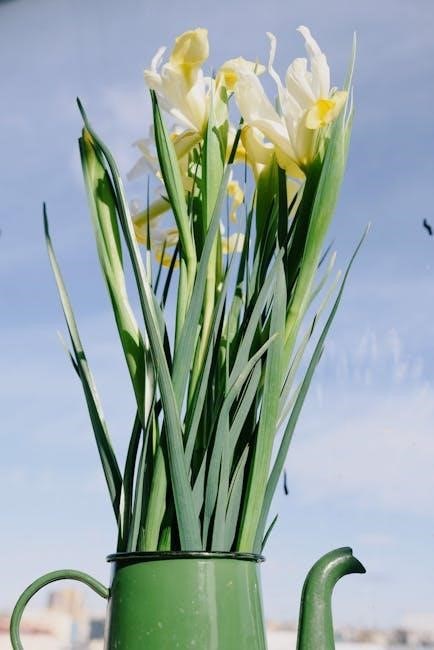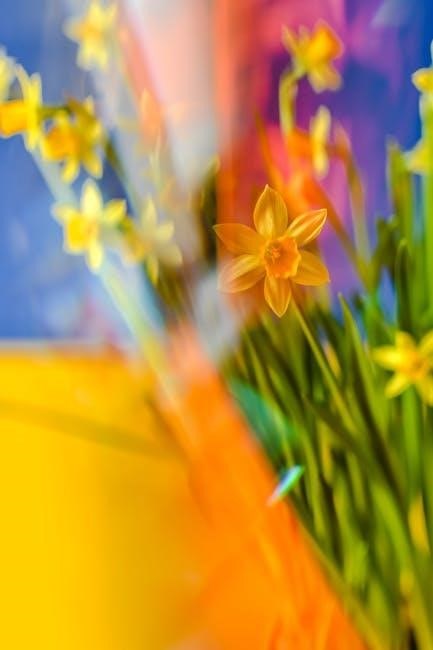Title of the Article
1.1. “I Wandered Lonely as a Cloud (Daffodils) by William Wordsworth”
This iconic poem, commonly known as Daffodils, captures the beauty of nature and the poet’s emotional response to it, written by the renowned Romantic poet William Wordsworth.
“I Wandered Lonely as a Cloud”, commonly known as Daffodils, is one of William Wordsworth’s most celebrated poems. Written between 1804 and 1807, it reflects the poet’s profound connection with nature. The poem vividly captures the sight of golden daffodils swaying in the breeze, evoking feelings of joy and tranquility. Its themes of beauty, memory, and the spiritual impact of nature resonate deeply. This poem is widely studied and admired, with numerous PDF versions available online, offering insights into its historical context and literary significance. It remains a cornerstone of Romantic literature, inspiring readers for generations.
“I Wandered Lonely as a Cloud” is a timeless masterpiece reflecting Wordsworth’s emotional response to nature. It captures the beauty of daffodils and their profound impact on the poet.
2.1; Overview of the Poem and Its Significance
“I Wandered Lonely as a Cloud” is a celebrated lyric poem by William Wordsworth, first published in 1807. It reflects the poet’s profound connection to nature, capturing the vivid imagery of daffodils swaying in the breeze. The poem is a masterpiece of Romantic literature, emphasizing themes of beauty, solitude, and the enduring power of memory. Its significance lies in its ability to evoke deep emotional responses, showcasing Wordsworth’s unique ability to find inspiration in the natural world. This poem remains one of his most beloved works, continuing to inspire readers with its timeless charm and universal appeal.
2.2. Brief Biography of William Wordsworth
William Wordsworth (1770–1850) was a leading English Romantic poet, celebrated for his focus on nature, emotion, and the human experience. Born in Cumberland, he developed a deep connection to the natural world from an early age. Wordsworth studied at Cambridge University and was influenced by the French Revolution, which shaped his political and philosophical views. He married Mary Hutchinson and had five children. His sister, Dorothy, was a significant influence on his work. Wordsworth became Poet Laureate in 1843 and is best known for works like “I Wandered Lonely as a Cloud” and Lyrical Ballads, co-authored with Samuel Taylor Coleridge. His poetry left a lasting legacy, inspiring future generations with its profound exploration of nature and the human spirit.

2.3. Historical Context of the Poem
William Wordsworth wrote “I Wandered Lonely as a Cloud” in 1804, during the Romantic era, a time of heightened interest in nature and human emotion; The poem reflects Wordsworth’s personal experiences, including a walk with his sister Dorothy near Ullswater in 1802, where they saw daffodils swaying in the breeze. The French Revolution’s emphasis on liberty and individualism also influenced Wordsworth’s focus on personal reflection and nature’s beauty. Published in 1807, the poem became a cornerstone of Romantic literature, celebrating the natural world as a source of inspiration and solace during an era of industrial and social change.

The Full Text of the Poem
I wandered lonely as a cloud, That floats on high o’er vales and hills, When all at once I saw a crowd, A host of golden daffodils; Beside the lake, beneath the trees, Fluttering and dancing in the breeze.
3.1; “I Wandered Lonely as a Cloud” in Its Original Form
The original poem, written in 1804 and published in 1807, captures the poet’s serene encounter with daffodils. It begins:
I wandered lonely as a cloud,
That floats on high o’er vales and hills,
When all at once I saw a crowd,
A host of golden daffodils;
Beside the lake, beneath the trees,
Fluttering and dancing in the breeze.
Wordsworth’s vivid imagery and emotional depth reflect his connection to nature, a hallmark of Romantic poetry. The poem’s original form remains a timeless celebration of beauty and joy.

Background Information
Inspired by a walk with his sister, Wordsworth wrote ‘Daffodils’ in 1804, published in 1807, revised in 1815, a key Romantic poem celebrating nature’s beauty.
4.1. The Inspiration Behind the Poem
The poem was inspired by a walk William Wordsworth took with his sister Dorothy near Ullswater Lake in 1802. Dorothy’s journal entry described the vibrant daffodils swaying in the breeze, which deeply moved William. The sight of these golden flowers dancing by the lake left a lasting impression on him, symbolizing beauty, joy, and the healing power of nature. Two years later, this memory inspired Wordsworth to compose the poem, capturing the emotional and spiritual connection he felt with the natural world. The daffodils became a timeless symbol of nature’s ability to uplift the human spirit.
4.2. The Role of Nature in Wordsworth’s Poetry
Nature was a central theme in Wordsworth’s poetry, often depicted as a source of inspiration, solace, and spiritual renewal. In Daffodils, the natural landscape is portrayed as alive and vibrant, evoking deep emotions and introspection. Wordsworth viewed nature not merely as a backdrop but as an active force that shapes the human experience. His focus on the beauty and tranquility of the natural world reflects his belief in its ability to nurture the soul and foster creativity. This perspective, common in Romantic poetry, emphasizes nature’s role in awakening the mind and heart to profound truths and inner peace.
4.3. The Evolution of the Poem Through Its Revisions
The poem underwent notable revisions after its initial publication in 1807. Wordsworth refined the language and structure, enhancing the imagery and emotional depth. The 1815 version, published in Poems by William Wordsworth, introduced minor but significant changes, such as altering “floats on high o’er vales and hills” to “floats on high o’er vale and hill.” These revisions reflect Wordsworth’s meticulous attention to detail and his desire to perfect the poem’s flow and impact. The final version remains the most celebrated, showcasing his mastery of capturing nature’s beauty and its profound effect on the human spirit.

Thematic Analysis
The poem explores themes of beauty, joy in nature, solitude, and the power of memory, emphasizing the spiritual connection between the individual and the natural world.
5.1. The Theme of Beauty and Joy in Nature
The poem vividly portrays the beauty of nature through the imagery of golden daffodils swaying in the breeze, evoking a sense of joy and delight. Wordsworth captures the vibrant scene by comparing the daffodils to stars and describing their dance-like movement, which fills the poet’s heart with pleasure. The natural setting—beside a lake, under trees—heightens the sense of wonder and tranquility. The poem emphasizes how nature’s beauty can uplift the spirit, offering solace and happiness. This theme reflects Wordsworth’s belief in nature’s power to inspire and heal, making it a central element of his Romantic poetry.
5.2. The Concept of Solitude and Contemplation
The poem begins with the poet wandering “lonely as a cloud,” establishing a sense of solitude. This isolation allows for deep contemplation, as the poet reflects on the natural scene before him. The daffodils, though part of a vibrant crowd, do not disrupt this solitude but rather enhance it, inviting introspection. The serene environment—by the lake, beneath trees—fosters a quiet, meditative state. Wordsworth’s focus on personal reflection highlights the value of solitude in connecting with nature and oneself, a recurring theme in Romantic literature that emphasizes inner peace and self-discovery through nature’s calming presence.
5.3. The Power of Memory and Imagination
The poem vividly illustrates the transformative power of memory and imagination. Wordsworth recalls the daffodils long after the encounter, showing how memory preserves beauty and joy. The imagination transforms this recollection into a vivid, emotionally resonant experience, allowing the poet to relive the scene in his mind. The daffodils become a symbol of enduring happiness, evoked by memory and nurtured by the imagination. This interplay highlights the mind’s ability to cherish and reinterpret experiences, emphasizing the Romantic belief in the mind’s creative power to find meaning and solace in nature’s beauty, even in moments of solitude or darkness.
5.4. The Spiritual Connection to Nature
The poem embodies a profound spiritual connection to nature, portraying it as a source of divine inspiration and solace. Wordsworth’s encounter with the daffodils evokes a sense of awe and wonder, suggesting nature’s ability to transcend the mundane and touch the soul. The vibrant imagery of the daffodils dancing in the breeze symbolizes the joy and beauty that nature embodies, which Wordsworth sees as a reflection of the divine. This spiritual resonance not only uplifts the poet but also reinforces the idea that nature has the power to comfort and inspire, offering a deeper connection to the world and oneself.
Literary Devices and Style
The poem employs similes, personification, and vivid imagery to create a visual experience. Rhyme and rhythm add musicality, while symbolism enhances the emotional depth of nature.
6.1. The Use of Similes in the Poem
Wordsworth masterfully uses similes to enhance the poem’s imagery and emotional depth. Comparing himself to a wandering cloud, he conveys a sense of solitude and freedom. Similarly, the daffodils are likened to stars, emphasizing their brightness and endless beauty. These comparisons create vivid connections between the natural world and human emotion, making the scene more relatable and immersive. The similes also highlight the poet’s awe and admiration for nature, reinforcing the central theme of joy and wonder inspired by the daffodils.
6.2. Personification and Its Impact on the Reader
Personification is a powerful tool in the poem, where Wordsworth attributes human qualities to nature. The daffodils are described as “fluttering and dancing in the breeze,” giving them a sense of life and joy. This technique creates a vivid and dynamic image, drawing the reader into the serene landscape. By personifying the flowers, Wordsworth evokes a deeper emotional connection, making the natural world feel accessible and relatable. This literary device enhances the poem’s beauty and emphasizes the uplifting spirit of the scene, leaving a lasting impression on the reader.
6.3. The Role of Imagery in Creating a Visual Experience
Imagery plays a crucial role in crafting a vivid visual experience in the poem. Wordsworth’s descriptions of the daffodils as a “host” and “golden” create a striking mental image. The “fluttering and dancing in the breeze” evokes movement, while the setting “beside the lake, beneath the trees” paints a serene backdrop. These visual elements immerse the reader in the scene, fostering a connection with nature. The imagery not only enhances the poem’s beauty but also reinforces its themes of joy and tranquility, making the experience memorable and impactful for the reader.
6.4. The Significance of Rhyme and Rhythm
The poem’s rhyme and rhythm are essential in creating its musicality and emotional depth. The ABAB rhyme scheme contributes to a lyrical flow, while the iambic pentameter provides a steady, rhythmic pulse. This structure mimics the natural movement of the daffodils swaying in the breeze, enhancing the poem’s vivid imagery. The rhythmic cadence also reflects the poet’s introspective tone, allowing readers to connect with the serene and joyful atmosphere. Wordsworth’s use of rhyme and rhythm transforms the poem into a melodic celebration of nature, making it both memorable and emotionally resonant.
6.5. Symbolism in the Poem
The daffodils in the poem symbolize natural beauty, joy, and the inner wealth they bring to the poet. Their golden color represents vibrancy and hope, while their dancing motion embodies carefree delight. The flowers also symbolize the enduring power of nature, as they return annually, much like the recurring memories that bring comfort to the poet. Additionally, the daffodils serve as a metaphor for the transience of life and the lasting impact of fleeting moments of beauty. Through this symbolism, Wordsworth connects the external beauty of nature to the poet’s internal emotional state, creating a profound reflection on life and memory.
Structure and Form
The poem is structured in quatrains with an ABAB rhyme scheme, creating a rhythmic flow. Wordsworth’s use of iambic pentameter enhances the natural, lyrical quality of the verse.
7.1. The Stanza Structure of the Poem
The poem is divided into four quatrains, each consisting of four lines with an ABAB rhyme scheme. This structure creates a rhythmic and balanced flow, reflecting the natural cadence of the poet’s thoughts. The quatrains allow Wordsworth to build his narrative gradually, moving from solitude to the vivid imagery of the daffodils and finally to the lasting emotional impact of the experience. The consistent stanza structure enhances the poem’s lyrical quality, making it both accessible and memorable. This form also mirrors the poet’s contemplative and reflective tone, emphasizing the connection between nature and inner peace.

7.2. The Use of Quatrains and Their Effect
The poem is composed of four quatrains, each with an ABAB rhyme scheme, creating a harmonious and balanced rhythm. This structure allows Wordsworth to present his thoughts and imagery in a clear, organized manner. The quatrains build gradually, starting with the poet’s solitude, then introducing the daffodils, and finally reflecting on the lasting emotional impact. The consistent use of quatrains enhances the poem’s musicality, making it both lyrical and engaging. This rhythmic structure also mirrors the natural, flowing movement of the daffodils themselves, reinforcing the connection between the poet and nature. The quatrains’ repetitive pattern adds to the poem’s memorability and timeless appeal.
7.3. The Role of Meter in the Poem’s Flow

The poem primarily employs iambic pentameter, creating a rhythmic and natural flow that mirrors the serene atmosphere of nature. This meter contributes to the poem’s musical quality, enhancing its lyrical appeal. The steady rhythm evokes the continuous movement of the daffodils and the poet’s tranquil state of mind. It also supports the poem’s reflective tone, allowing the reader to experience the gradual unfolding of the poet’s emotions and memories. The meter plays a crucial role in maintaining the poem’s balance and harmony, ensuring a smooth and immersive reading experience that aligns with its themes of beauty and contemplation.

Cultural and Historical Impact
Daffodils remains a cornerstone of Romantic poetry, inspiring countless adaptations, including a modern rap version, ensuring its enduring relevance and appeal across generations and cultural boundaries.
8.1. The Poem’s Reception in the 19th Century
First published in 1807, Daffodils gained gradual recognition, becoming a beloved piece of Romantic literature. Initially, its simplicity raised eyebrows, but Victorians embraced its accessible beauty. The poem’s vivid imagery and emotional depth resonated deeply, reflecting the era’s growing appreciation for nature. Its themes of solitude and joy struck a chord, making it a favorite among readers seeking solace in an industrializing world. By the late 19th century, it was celebrated as a quintessential expression of Romantic ideals, solidifying Wordsworth’s legacy and influencing later poets and writers.
8.2. Modern Interpretations and Adaptations
In the modern era, Daffodils continues to inspire fresh perspectives, with its themes of nature and memory remaining universally relevant. The poem has been adapted into various forms, including animated videos, musical compositions, and even a rap version aimed at engaging younger audiences. Educators often use it in curricula to teach Romanticism and poetic devices. Digital platforms have further amplified its reach, with interpretations ranging from visual art to social media tributes. Its timeless appeal lies in its ability to evoke joy and contemplation, making it a cherished piece across generations and cultures.

8.3. The Poem’s Influence on Other Artists and Writers
Daffodils has profoundly influenced numerous artists and writers, inspiring works that reflect its themes of nature and emotional resonance. Many poets have emulated Wordsworth’s focus on personal experience and the natural world. The poem has also inspired visual artists, with interpretations in paintings and photography capturing the vibrant imagery of the daffodils. Musicians and composers have adapted its themes into songs and scores, while writers often reference it in exploring themes of memory and joy. Its enduring impact highlights the universal appeal of Wordsworth’s vision, continuing to inspire creativity across diverse mediums and generations.

William Wordsworth’s Daffodils remains a timeless masterpiece of Romantic poetry, capturing the essence of nature’s beauty and its profound impact on the human spirit. The poem’s vivid imagery, emotional depth, and universal themes continue to resonate with readers worldwide. Its exploration of joy, memory, and the spiritual connection to nature has inspired countless adaptations and interpretations across art, music, and literature. As a cornerstone of English literature, Daffodils endures as a celebration of life’s simple yet profound moments, reminding us of the transformative power of nature and the human experience.
